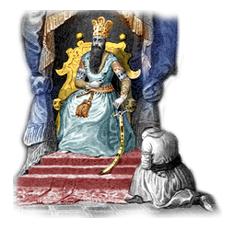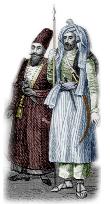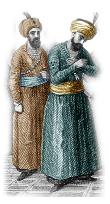

Purim is named from the Hebrew
word pur, meaning "lot," after the lots Haman tossed to choose the month in
which to destroy the Jews. In ancient times the holiday was also called the
Day of Mordecai, because along with Queen Esther, Mordecai is a hero of the
story.
Mordecai son of Jair, from the tribe of Benjamin, descended from King Saul and
later Jews who were exiled to Babylon. He himself rose to become a courtier
and consultant to King Ahasuerus of Persia. After Esther's parents died, he
became her foster father.
It was Mordecai's idea for Esther to hide her identity when she became queen,
and it was to Esther as queen that he went after he overheard two men plotting
to assassinate the king. Esther gave the information to Ahasuerus, the men were
executed, and the incident, with Mordecai's name, was inscribed in the king's
annals.
In some respects, Mordecai's struggle with Haman was an extension of the ancient
Israelite war with Amalek. Mordecai's ancestor Saul had spared the life of the
Amalekite King Agag. Mordecai refused to bow to Agag's descendent Haman, and
Haman, in turn, tried to avenge himself by planning to exterminate the Jews
of Persia.
Mordecai won on every score. First, King Ahasuerus, unable to sleep one night,
chanced on the record of Mordecai's good deed on his behalf. Next, as a reward,
the king ordered Haman, of all people, to parade Mordecai through the streets
of Shushan on a royal horse, proclaiming, "This is what is done for the man
whom the king desires to honor!" (Esther 6:11). Finally, Haman lost his life
after Esther denounced him to the king, and Mordecai, of all people, replaced
him as minister.
Did any of this Purim story really happen? Plenty of historians say it didn't.
They point out that while King Ahasuerus may have been the Persian king Xerxes
I, who reigned from 486 to 465 B.C.E., no references to the events described
in the Scroll of Esther exist in Persian sources. Furthermore, the names Esther
and Mordecai sound suspiciously like those of the Babylonian gods Ishtar and
Marduk, making it likely that our story is a retelling, maybe a parody, of some
ancient folktale or myth. Some scholars argue that the whole story was invented,
possibly during the Second Temple era, to give a Jewish slant to an old, popular
spring festival.
 The
sages had their own problems with the Purim saga. What was this Jewish woman
doing in a Persian king's harem, changing her name from Hadassah to Esther,
paying no attention to dietary laws, and hiding her identity? Worse still, why
is there no reference to God in the entire Book of Esther — not a prayer
for salvation when Esther calls for a public fast, not a prayer for thanksgiving
when salvation does arrive? The
sages had their own problems with the Purim saga. What was this Jewish woman
doing in a Persian king's harem, changing her name from Hadassah to Esther,
paying no attention to dietary laws, and hiding her identity? Worse still, why
is there no reference to God in the entire Book of Esther — not a prayer
for salvation when Esther calls for a public fast, not a prayer for thanksgiving
when salvation does arrive?
They argued the matter back and forth and finally agreed to accept Purim as
a legitimate festival, although a minor one, on which work is permitted. They
concluded that though the book appears to be secular, it was actually divinely
inspired, perhaps more than any other biblical book. The only reason God is
not mentioned in it is because God's presence is hidden, working behind the
scenes. How else explain the remarkable victory of the Jewish people than through
divine providence, which shapes all events without our awareness? Why, even
the thorn tree, on which Haman the "thorn" was hanged, had been created for
that very purpose from the beginning of the universe.
So be joyful on Purim, the rabbis commanded, and be sure to follow the practice
Esther and Mordecai instituted of sending gifts to one another, known as mishlo'ah
manot, and especially of distributing food and money to the poor.
Without worrying about the holiday's origins, Jews have accepted the rabbinic
injunction and celebrated in high spirits, with carnivals, masquerades, and
Purim shpiels — plays and poems that satirize the story and its characters.
Even cross-dressing, men as women and women as men, is permitted on this day.
Families gather on Purim afternoon to eat a Purim se'udah, a hearty meal
that in Ashkenazi homes may include triangular meat-filled pastries called kreplach,
and end with the festival's favorite delicacy, hamantaschen. Loosely translated
as "Haman's pockets," these are small three-cornered cakes filled with poppy
seeds or jellied fruits. Like the kreplach, they mock the three-cornered
hat that Haman supposedly wore. A Sephardic Purim meal might feature fine egg
noodles tossed with lemon sauce and known as "Haman's hair," and fried cookies
called " Haman's ears," or oznei Haman in Hebrew.
In the synagogue, readers chant from the Megillah (scroll) in a melody
of its own, folding the parchment like a letter, unlike the Torah scrolls which
are unrolled. The folding is a reminder of letters Esther and Mordecai sent
to the Jewish community creating the holiday.
 The
highest spirits of all come from a saying by the fourth-century Babylonian sage
Rava that it is a duty to get so drunk on Purim that you cannot distinguish
between the phrases The
highest spirits of all come from a saying by the fourth-century Babylonian sage
Rava that it is a duty to get so drunk on Purim that you cannot distinguish
between the phrases  "Blessed be Mordecai" and
"Blessed be Mordecai" and  "Cursed be Haman." Naturally, the idea has won many followers (despite a few
hand-wringing rabbis who worry about excesses), but it actually raises some
sobering questions. Should one truly try to forget the difference between the
good Mordecai and the evil Haman? And isn't this supposed to be a holiday of
remembering and not forgetting?
"Cursed be Haman." Naturally, the idea has won many followers (despite a few
hand-wringing rabbis who worry about excesses), but it actually raises some
sobering questions. Should one truly try to forget the difference between the
good Mordecai and the evil Haman? And isn't this supposed to be a holiday of
remembering and not forgetting?
But perhaps what Rava advocated was something else: Purim offers a moment of
total victory, rare in the Jewish past. Why not put aside our anger, even our
memory, for that moment and simply be happy? Then, too, Jewish tradition teaches
us not to gloat over the destruction of our enemies. The Megillah reader, for
example, chants the names of Haman's ten sons, who are also killed, in one breath
so as not to dwell in detail on their deaths. It may be that melding Haman's
name to Mordecai's for a while is a way of preventing ourselves from gloating
even while cheering success. It may also be that drinking to oblivion is the
only way to quell the pain of a history of Haman-like hatreds.
Purim carries another serious message that makes it resonate with meaning far
beyond the day itself. In the story, Esther hesitates at first about approaching
the king, knowing that she is putting her life in jeopardy. Mordecai says, "Do
not imagine that you, of all the Jews, will escape with your life by being in
the king's palace. On the contrary, if you keep silent in this crisis, relief
and deliverance will come to the Jews from another quarter, while you and your
father's house will perish..." (Esther 4:13-14).
It is a statement of connectedness — of Esther to the Jewish people, of
Jews to one another, and, ultimately, of all people to all others. Nobody is
safe no matter how exalted his or her position, Mordecai is saying, unless people
assume responsibility for one another. For so long as even one monster is allowed
to remain out there casting lots, who knows who will be the next victim?
 |
 From:
Jewish Days: A Book of Jewish Life and Culture Around the World (Farrar
Straus Giroux 1996). From:
Jewish Days: A Book of Jewish Life and Culture Around the World (Farrar
Straus Giroux 1996). |
 |
Francine
Klagsbrun has written more than a dozen books and numerous articles on social,
religious, feminist and family issues. She is a columnist for "The Jewish
Week" and "Moment" magazine, and lectues extensively throughout the United
States. |

|



